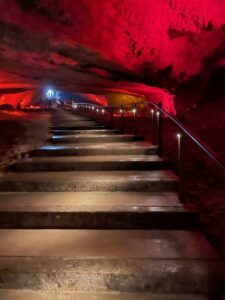
KFAR SABA, Israel — It’s summer in Israel and that means hot, sunny, and no chance of rain. So you can be sure that you won’t be caught in a rain shower – but you’ll be hot. What’s “hot” in the Sharon area on the coastal plain where we live? About 33 degrees Celsius (Israel, like almost the entire world, uses the metric system) or 90 degrees Fahrenheit. I’m used to the heat, which naturally is lower in the mornings and evenings, but it’s the humidity that can make you really uncomfortable.
Nevertheless, the humidity doesn’t affect me most; Michal feels it much more. For that reason we took a quick, three-day holiday recently in Jerusalem with friends. While it’s just as hot there during the day, by early evening the temperature drops dramatically and there’s very little humidity. Why? Jerusalem’s elevation is almost 3,000 feet.
This trip we didn’t take the train because we were going over the weekend, when traffic would be light ,parking abundantly available, and no public transportation (because it’s Shabbat). We stayed in a “B&B” rental (minus one B) in the Abu Tor neighborhood, known for its mixed Jewish/Arab population and its wonderful views of the Old City. We weren’t overjoyed with our choice of accommodations, we’ll probably stick to hotels for short-duration stays.

Once we arrived, our first destination was King Solomon’s Quarries (aka Zedekiah’s Cave) which is accessed from an opening in the Old City walls near the Damascus Gate. The site was a small natural cave from which, according to common belief, stone blocks were quarried to construct the 1st Temple (10th C. BCE). Hence its nickname, King Solomon’s Quarries. Much later, in the 2nd Temple period (516 BCE – 70 CE), the cave was enlarged to a huge subterranean stone quarry extending under the residences and buildings of the Old City. This quarry supplied the stone for many magnificent buildings in Jerusalem.
“The cave reopened with a brand-new multimedia production at the beginning of August and offers visions, mysterious lights and strange sightings under a very ghostly aura.Wearing audio guides available in English, Arabic and Hebrew, visitors experience lights, sounds, and colors that bring biblical tales and legends to life. Watch as cherubs and angels fly through the cave, and follow King Zedekiah as he flees from the Babylonians.
“Over the centuries, Jewish sources suggested that Solomon brought a stone-eating worm called shamir to the quarry, a creature that could bore through rocks. And perhaps they were right. In 2019, scientists discovered a strange species of shipworm in the Philippines that lives within a small stretch of the Abatan River that can actually cut through stone. To hear the story and to watch an artist’s vision of the shamir at work, join a tour through Zedekiah’s Cave. (Source: Times of Israel)
Personally, I wasn’t overwhelmed by the new exhibit, but it’s great for kids. Best was the cool temperatures in the cave, accompanied by dew dripping off the walls and ceilings. Nevertheless, when we exited outside, we were almost instantly uncomfortably warm.
The cooler alleys of the Old City bazaar beckoned, just a short walk away via the picturesque Damascus Gate. Immediately, we were in the Arab section of the circuitous bazaar lanes. It wasn’t overly crowded with tourists, although there were more than a few large groups of tourists led by guides speaking several foreign languages, as well as Hebrew. The Arab shop owners were often seated, smoking cigarettes or drinking coffee (or both) in front of their small shops or even smaller stalls. These contained everything from baked goods, spices, nuts, fruits and vegetables, to clothing, sundries, jewelry, sweets, religious objects for the three Abrahamic faiths, and a lot more.
After quite a while, having traversed much of the Arab and Christian sections, we emerged near the newly refurbished Tower of David Museum – a must see for visitors to Jerusalem. There our friends directed us down a short alley by the Jaffa Gate to the lovely, secluded courtyard of the Versavee Restaurant. There we enjoyed cool drinks accompanied by nuts and olives. Besides the beautiful 19th century buildings in the courtyard, there was an ancient column with legible writing celebrating the Maximus Legion of Roman soldiers. We enjoyed our respite in the courtyard and, having perused the enticing menu, put it on our list of restaurants for our next visit to the Old City.
The next morning was a real treat, a visit to the Shai Agnon House. S.Y. Agnon, as he was known, won the Nobel Prize for Literature in 1966 and is one of Israel’s most revered writers, despite (or because of) his writings’ complexity. I read his wonderful 1945 novel, Only Yesterday, which (even in translation) captivated me with its wonderful, rhythmic style.
Born Shmuel Yosef Czaczkes (1888-1970) in Galicia (that part of Austro-Hungary where the Kramers hailed from), the young, literary-minded Agnon made Aliyah to Ottoman Palestine in 1908. “Agnon claimed that his inspirations were ‘first and foremost the sacred scriptures, and after that, the teachings of the medieval Jewish sages, and the spectacles of nature and the animals of the earth.’ He returned to Europe six years later to live in Germany. Following the destruction of his house and library in Homburg by fire, he returned to Palestine in 1924.
“What makes Agnon’s writing treasured and unique is simultaneously what makes reading his stories so challenging for the modern reader. While he is well known and admired in Israel, he is virtually unknown to those outside the circle of Hebrew literature. One reason for this is the difficulty of translating his work. Agnon’s writing is embedded with wordplays, acrostics and anagrams and his text style is sometimes obscured when translated. His life and work has become symbolic of the hopes and longing of the Jewish state, a state that is at once ancient and modern.” (Source: My Jewish Learning)
Touring Agnon’s house and museum in Jerusalem’s Talpiot neighborhood was a real treat. The house originally had a commanding view of the city and countryside, but unfortunately that is almost totally obscured today. There is a huge library (his first two large libraries were destroyed in fires), an enclosed verandah facing the (vanished) view, a large garden and roof. Most outstanding is the incredible amount of information about Agnon presented there, much more than I’ve found in similar home “museums” to famous notables.
Next we went to the Gazelle Valley Park, the largest park in Jerusalem. What makes this park unique is the herd of nearly 100 gazelles which roam free amid the ponds, woods, and open areas. The park was founded after a successful struggle was waged by a coalition of residents and public bodies against a construction plan which threatened to harm one of the city’s most important nature sites. Their efforts led to a unique municipal nature park that plays a recreational and educational role in the conservation of Jerusalem’s natural assets. It’s truly an excellent example of a large public space dedicated to the benefit of residents and visitors alike. Included in the park is a large, educational display by the publicly owned Gihon Water Corporation, named for the eponymous Gihon Spring, the largest in the Jerusalem mountains as well as guides full of interesting information.
The last stop of the day was an aborted visit to the King David Hotel’s lovely terrace cafe, which unfortunately had stopped serving food until supper time. Undaunted, we walked across the street to the equally impressive Jerusalem International YMCA, where we had coffee and delicious apple pie a la mode in their outdoor cafe (with a more mundane view compared to the one across the street). Both wonderful buildings were built and opened in the early 1930s. The YMCA was designed by the American architect Arthur Loomis Harmon of Shreve, Lamb and Harmon, who also designed the Empire State Building. The Jerusalem YMCA housed the city’s first heated swimming pool and first gymnasium with a wooden floor.
The YMCA complex contains the fabulous 100,000-square-foot “Sylvan Adams Sports Center,” which opened in 2022 and was financed by the redoubtable, eponymous Canadian-Israeli millionaire. Since making Aliyah, Adams has brought numerous big-time, international sporting events to Israel, starting in 2018 with the world-class Giro d’Italia bicycle race, held for the first time outside of Europe since its founding more than a century ago! Sylvan Adams is on a non-stop mission to shape Israel through his vision: building cohesion by sports, culture, and science. Producing events that were said “couldn’t done” is this man’s forte.
That evening we walked from our lodging to the nearby German Colony for an excellent dinner in one of the restaurants on Emek Refaim St. The street represents a trendy segment of Jerusalem culture and society, lined with restaurants, cafes, and boutique stores often placed within the lovely, solid German Templar style buildings in the area. The neighborhood was established in the second half of the 19th century by members of the German Temple Society.
We had a very nice breakfast the next morning in the newish, DeJa Bu restaurant, located near the new Museum of Tolerance and across the street from the former American Consulate. Our final stop was one of our favorite Jerusalem attractions, the Israel Museum. There, Michal and I explored a new exhibit, the “Wonders of the Deep” exhibition. Located in the children’s wing and full of kids and their parents, we observed the hands-on workshops, the many recreations and artifacts of the “deep,” and artwork associated with the sea. We then split up and explored other parts of the museum at our leisure.
After joining our friends for a last cup of coffee, we left the museum and had an easy drive back to the coastal plain and home, where we opened the car door and immediately missed the humidity-free climate that we had just enjoyed.
There’s always someplace familiar or new to visit in Israel. And even if you’ve been several times, your destination will probably have been revamped or refurbished since your last visit. Come and find out for yourself!
Steve Kramer is a freelance writer based in Kfar Saba. He may be contacted via steve.kramer@sdjewishworld.com
Happy that your misfortune at the King David led you across the street to the Jerusalem International YMCA. Thank you including the Y in your beautiful story of your visit to Israel and Jerusalem.